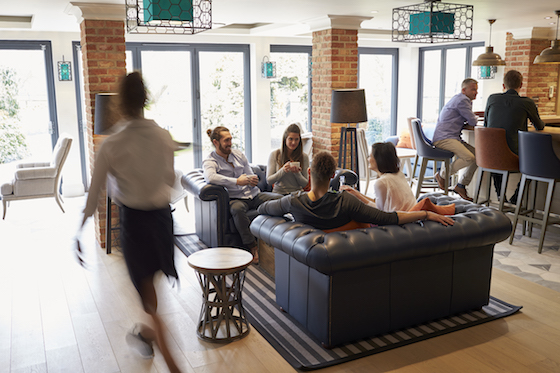Never underestimate the human urge to connect with other humans. That basic need is what many hotels are counting on as they prepare to welcome guests in the midst of a pandemic. It’s especially relevant to social brands, but so is the need to operate responsibly — to protect the staff as well as the guest.
“There’s a human need to mix, mingle, see and be seen, flirt, interact. I don’t think COVID will do anything to seriously damage that need,” says Piers Schmidt, founder of the Luxury Branding consultancy. The hip factor and the living room nature of social brands is part of their DNA, the quality that drives reservations and builds a buzz among locals. How will that look when COVID social distancing, masks and sanitation protocols crash the party?

The answer: different, but not drastically so.
Crowd control, a primary concern, can be tackled from a number of angles — limiting the number of guests in a space will naturally allow more social distancing. Hotels with open restaurants can control the guest count by requiring reservations; bar access can be limited to hotel guests. Lobbies can still fulfill a need to connect, but safely, without major changes.
Re-engineering for safety
Hilton, with lobby-centric brands like Tru and Embassy Suites, plans to engineer distancing through layout tweaks. “We envision the creative use of existing furniture, planters and reorganization of existing architectural screens or shelves within our hotels as the best way of achieving these social distancing mandates and reducing the cost and time that it will take to modify these spaces as our hotels reopen,” says Larry Traxler, Hilton’s senior vice president of global design. When possible, fresh air will flow throughout the hotel.
In recent years, Hilton properties have incorporated more biophilia, natural materials and light, and Traxler says those factors help blur the line between indoor and outdoor spaces, a valuable quality in the current environment.
Perhaps the ultimate test for whether hotels can ensure a socially gratifying and safe experience is happening in Las Vegas, where the lights have gradually been switched on at Strip properties. MGM took a measured approach to reopening its properties, consulting with health experts to determine what steps made sense. Aside from stepped-up sanitation, they include plexiglass barriers at the front desk, most gaming tables and registers, daily health screenings and mask requirements and free COVID screening for employees, abundant signage to remind patrons of the need for social distancing and installation of handwashing sinks on the casino floor. The maximum pool capacity has been halved, and lounge chairs are spaced more generously than normal.
MGM patrons are required to wear masks as well (they weren’t when the properties initially opened). Each room is furnished with a COVID amenity kit, complete with a logoed mask, hand sanitizer and multifunction pen that can be used for opening doors, pressing keys and playing slots.
Technology has solved some age-old queuing issues: Digital keys are now standard, and restaurant guests can scan a menu and reserve a time to return.
The overall effect is designed to reinforce a safety message without spoiling the fun. “If you look around, 80% to 90% of what you saw before will be the same,” says John Flynn, MGM’s vice president of administration and head of health and safety strategy. The biggest changes — masked employees, plexiglass barriers and abundant signage—are designed to keep safety top of mind.
Over the course of a stay, Flynn says, guests get used to the changes. “People realize they can still get a glass of Champagne, go to the spa, enjoy fine dining, still have a fountain view suite. They can still do all the wonderful things they loved about Las Vegas.”
That’s the narrative MGM is promoting. “We keep saying, ‘Vegas done safely is still Vegas,’” Flynn notes.
All hotels will need to balance their brand promise against projecting a safe image. “Hotels will need to find a way to deliver what they always did, while offering their assurance that they’re playing a part to conquer the spread of coronavirus,” Schmidt says, although he is skeptical of the efforts many hotel brands have rolled out.
“I think a lot of it is window dressing, to give everyone the comfort that the most that could be done is being done,” he says. “What brand isn’t going to take every possible step?”
In the face of social-distancing measures, Schmidt says social brands can capitalize on the need for human interaction by repurposing public spaces in a way that creates more meaningful connections with guests. Bringing in local artisans, writers and performers to activate lobbies and immerse guests in the local culture will help achieve that.
